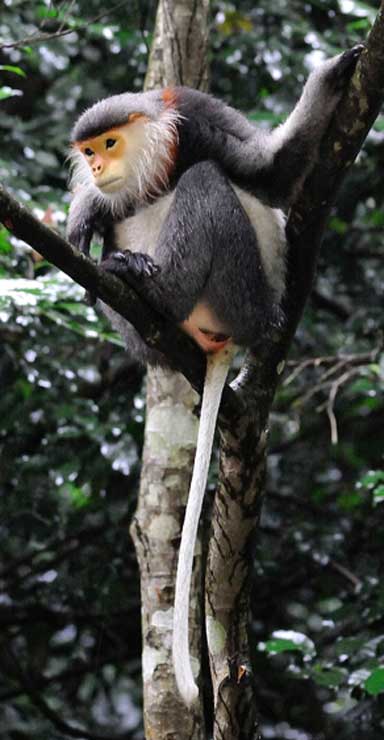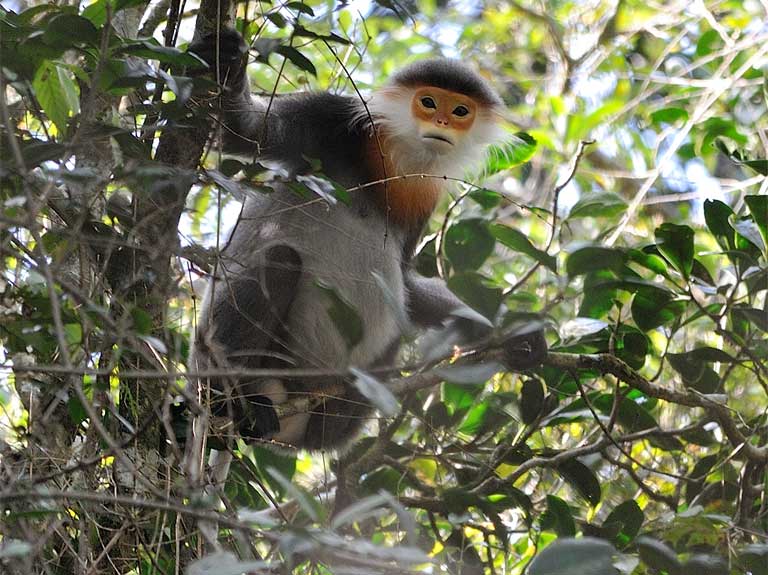- Grey-shanked doucs live in the forest canopy of the Central Highlands of Vietnam. Their numbers have been severely reduced by habitat loss and fragmentation, along with hunting for food and the pet trade.
- Fauna & Flora International (FFI) researchers located the 500+ animals in several subpopulations within the Kon Tum forest, which provides important connectivity to protected areas to the south and north, and across the border into Cambodia.
- FFI Vietnam is now developing a conservation strategy which may include ecotourism and forest patrols for the newly discovered population. Vietnam is home to 11 Critically Endangered primate species, and a priority for primate conservation in Southeast Asia and the world.

A new population of at least 500 Critically Endangered monkeys has been discovered in the Central Highlands of Vietnam. The grey-shanked douc is on the brink of extinction, so the discovery, which significantly increases their known population from previous estimates of 800-1000 individuals, could be a real boost for their conservation.
A field survey led by Fauna & Flora International (FFI) made the discovery in the Kon Tum Province. “To discover a large population of one of Vietnam’s most rare and precious animals is truly an honor,” said survey leader Trinh Dinh Hoang in a statement.
The grey-shanked douc is at risk as its forest habitat is lost and fragmented due to logging and the conversion of forest to agricultural land. The monkeys themselves are hunted — for food, medicinal products, and the pet and illegal wildlife trades.
Doucs are beautiful animals: they have golden facemasks and bibs, offset by white whiskers that frame their faces, with grey limbs and backs. They spend most of their time up in the forest canopy, and their diet is largely folivorous, or leaf-based.
“This really is Vietnam’s monkey; it is found nowhere else. This new population provides hope, but the species is sadly still on the brink of extinction — something that FFI is working hard to prevent,” said FFI Country Director Ben Rawson.

The December 2015 field survey that documented and confirmed the new population was beset by bad weather in the wake of a typhoon, Dinh Hoang told Mongabay. It rained heavily for two weeks, as the scientists did transect walks through the undergrowth, with visibility dropping at times to as little as 10 meters. The researchers also relied on the local knowledge of forest workers to find the monkeys.
This was the second recent survey to locate the new population, though it was Dinh Hoang’s first, and his initial sighting came after eight days looking without success. “Finally I saw, took photos and filmed this beautiful primate! I was so happy and excited,” he said.
FFI Vietnam is now developing a conservation strategy for the newly discovered animals, Rawson told Mongabay. “The approaches we take will largely depend on stakeholder discussions. However, clearly, getting these populations protected from hunting pressure is the first priority,” he said.
“The approaches will be different for different sub-populations,” he continued. “For example, we are exploring an ecotourism option with one ethnic minority village whose adjacent forests contain one of the smaller populations of doucs, with the tourism revenue providing an incentive for protection of the population and its habitat. At a second site with the largest douc population, we are working with the forest managers to set up patrols to protect the core area of the doucs distribution.”
The Central Highlands region in which the doucs were found already plays an important role in national and international conservation. “Broadly speaking the forests of Kon Tum provide important connectivity to the protected area network to the south and north as well as across the border into Cambodia,” Rawson explained. “However, in terms of the doucs, the discovered population is internally fragmented by roads and agricultural lands, with three main sub-populations discovered. These three sub-populations are not connected any more to either each other, or to other douc langur populations.”

“However, we feel confident that the size of the remaining populations and the size of the forest blocks in which they were discovered will be sufficient, given effective protection, to be self-sustaining,” Rawson said.
The grey-shanked douc is not alone in its plight, as ten other primate species are also critically endangered in Vietnam, including three of the most endangered species in the world.
“Vietnam is now considered to have 11 Critically Endangered primate species, and therefore represents a priority for conservation in Southeast Asia and indeed in the world,” Russell A. Mittermeier, Chairman of the IUCN Species Survival Commission’s Primate Specialist Group, stated. “Historical large-scale forest loss and persecution of primates for the illegal wildlife trade has resulted in the current situation requiring last ditch conservation efforts in many cases.”

FFI has been working to conserve Vietnam’s primate species since 1997, with the grey-shanked douc one of five priority species. Through partnerships with government, community, and corporate bodies FFI is helping to secure the future of these highly threatened species.
“There is a growing interest among the corporate sector in supporting the conservation of Vietnam’s unique biodiversity,” said Nguyen Thi Mai Thanh, Chairwoman/CEO of REE Corporation, one of Vietnam’s largest companies. “We have an obligation to contribute to a lasting legacy in relation to our natural heritage.
“The most immediate priority for the [doucs] is effective protection from hunting with a parallel need for habitat protection and avoidance of further habitat fragmentation,” Rawson told Mongabay.
“It will take the combined efforts of government, local communities, civil society, scientists and donors to ensure the long-term survival of this species,” he concluded, “but this is a step in the right direction.”
